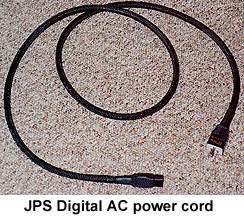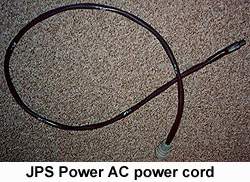![[SoundStage!]](../sslogo3.gif) Home Audio Home Audio Equipment Review |
|
| February 1998 Three Power Cords from JPS Labs by Mike Masztal
My first recollection of tweaking systems goes back to the late 70s when I applied Mortite to the underside of the platter to my Denon DP1000 turntable. It actually worked pretty well. The bass was tighter and the treble became more focused. Around that time Discwasher came out with Gold-Ends, an audiophile interconnect with gold-plated RCAs and thicker insulation. They worked pretty well, too. Maybe there was something to this "tweak" stuff after all. The later ramblings of certain audio personalities--addressing issues such as how the plumbing is routed through your house, carpet-fiber orientation, the acoustic effects of Sherwin Williams vs. Benjamin Moore paint, the type of cotton swab used for cleaning your ears, etc., etc., ad nauseum--made me wonder if I was losing it. Then power conditioners, cones, vibration-absorbing discs, and other now-mainstream devices seemed to gain a level of acceptance in the audiophile community. Tweaking was finally gaining a degree of respectability. When the esoteric interconnects and speaker cables came about, I didn’t have a hard time believing that they could clearly affect sound. Because these cables carry very low levels of current, it seemed plausible that they were a potential source of signal loss. But power cords? The type that carry enough current to kill you? Still, after reading some reviews of power cords, I decided to try several in my system. I initially got some of the "one size fits all" cords from some well-known manufacturers. Have you ever tried running through waist-deep water? Well, that’s how one of these cords seemed to affect the music. Three others had no significant effect, and one seemed to open up the sound a bit, but not enough to warrant spending $395. For a time, I dismissed power cords as only another way to help audiophiles part with their money, so I made my own cords using Hubbell plugs and high-quality 14x3-AWG cable. These offered subtle but obvious improvements over the stock cords. I then heard about the power cords from JPS Labs. I was told that they were unlike any cords I had previously experienced. Joe Skubinski, the brains at JPS Labs, sought a different approach to power-cord design. Thinking that different components might have different electrical needs, Joe set about looking at the particulars of each component and what each might take from or add to the AC line. The outcome of Joe’s work is three power cords: The Digital, Analog and Power AC cords. Cord Construction
Testing My approach to testing these cords was incremental--one component at a time. The prevailing wisdom says that digital components are most sensitive to AC hash, so that’s where I began my testing. Test 1: Digital AC on the DAC. WOW! More and better-defined bass as well as greater soundstage depth. A no-brainer improvement. Test 2: Digital AC on the transport. Not so great this time. Although the balance of the sound remained the same, the soundstage collapsed to about 70% of what it had been earlier. This was likely caused by the extensive filtering of the Digital AC cord--too much of a good thing. Test 3: Analog AC on the transport. An improvement. The Analog AC opened up the soundstage and removed a perceived veil over the sound. Test 4: Analog AC on the preamp. Much improved spatial resolution of instruments and voices. Harmonic textures also improved. Test 5: Power AC on the amps. Another no-brainer. Dramatic improvement in the pace of the music. While one of the cords I tested some time ago had the sonic effect of running through waist-deep water, the JPS Power AC cord eased the flow of the music, similar to running downhill. Conclusions The best sonic improvements in my system in descending order:
Anyone who ventures to the newsgroup rec.audio.opinion will find a great deal of debate on the attributes of after-market power cords. Sadly, some of the most scathing indictment of the performance of power cords comes from (those who claim to be) electrical engineers. Their position seems to be "if you can’t measure it, it can’t exist." They also seem to be hung up on specifications and have difficulty believing that an amp, like my Aronov monoblocks with 0.3% THD, can sound better than a Sony receiver with 0.01% THD. In my opinion, this is a silly belief system, especially when you remember what the "controlling scientific authority" of the time said about the claims of scientists such as Copernicus, Galileo, and Fleming. And no, I’m not making a comparison here between high-end audio and hard science. All I can say is that you should try using some after-market power cords for yourself and then make up your mind. As with all high-end components, there will likely be some system/component sensitivity, but this is precisely why JPS Labs’ design philosophy is so important. In my experience, one size doesn’t fit all. JPS Labs has three different power cords that offer each component its optimum level of AC power. I can heartily recommend the JPS power cords. They made a significant improvement in my system and have found a home there. The right combination of JPS cords can transform your system at a relatively moderate cost. No, they're still not exactly cheap, but the improvements may surprise you. I would like to congratulate Joe Skubinski for his ingenuity in designing component-sensitive power cords that really work. I expect others manufacturers will follow his lead. ...Mike Masztal
|
|
|
|
![[SoundStage!]](../sslogo3.gif) All Contents All ContentsCopyright © 1998 SoundStage! All Rights Reserved |
 Power cords...hmmm. Here's
another component/tweak that promises to transform your system to the nth degree, and with
some power cords costing $1000 or more, they're not cheap either. Being a skeptic, I
thought a little investigation was in order before I forked over my hard-earned money for
any power cord, regardless of cost.
Power cords...hmmm. Here's
another component/tweak that promises to transform your system to the nth degree, and with
some power cords costing $1000 or more, they're not cheap either. Being a skeptic, I
thought a little investigation was in order before I forked over my hard-earned money for
any power cord, regardless of cost. The Digital and Analog cords
are identical in appearance with the exception of the label on the plug itself. They come
in 6' lengths and are flexible, making installation and routing a breeze. Joe chose to use
a particular degree of filtering on the Digital and Analog cords. The Digital AC is a
highly filtered cord tuned specifically for digital gear, whereas the Analog AC has
slightly less filtering and is tuned specifically for use with analog
equipment--essentially everything but digital gear and power amps. The Power AC is quite
different in that it’s much heavier and stiffer. It is reported to be the
largest cord on the market with respect to conductor size and uses what JPS Labs calls
"Optimized Field Matrix" design, which reportedly takes advantage of the
cord’s own magnetic field to increase the effectiveness of meeting an
amplifier’s instantaneous current demands. Heady stuff.
The Digital and Analog cords
are identical in appearance with the exception of the label on the plug itself. They come
in 6' lengths and are flexible, making installation and routing a breeze. Joe chose to use
a particular degree of filtering on the Digital and Analog cords. The Digital AC is a
highly filtered cord tuned specifically for digital gear, whereas the Analog AC has
slightly less filtering and is tuned specifically for use with analog
equipment--essentially everything but digital gear and power amps. The Power AC is quite
different in that it’s much heavier and stiffer. It is reported to be the
largest cord on the market with respect to conductor size and uses what JPS Labs calls
"Optimized Field Matrix" design, which reportedly takes advantage of the
cord’s own magnetic field to increase the effectiveness of meeting an
amplifier’s instantaneous current demands. Heady stuff.